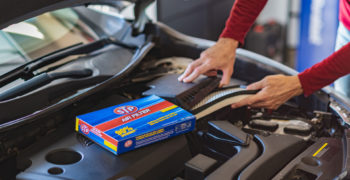WHAT’S THE DIFFERENCE BETWEEN A CABIN AIR FILTER AND AN ENGINE AIR FILTER?
The main similarity between the cabin air filter and engine air filter is their purpose. Both are designed to protect your vehicle from dust, dirt, pollen, and other potentially harmful contaminants that can enter through the air intake system. The key difference with these two types of filters lies in where they are located within your car: the engine air filter can be found near the front of your vehicle under the hood, while the cabin air filter is usually found inside the passenger compartment near either side or behind glove box.
Another difference between these two filters is their size. While the engine air filters are usually considerably larger than cabin air filters due to the higher airflow they need to handle, they also have a much more complicated design which allows them to trap particles effectively. Cabin air filters on the other hand tend to be much smaller in size and simpler in design as they need to neatly fit within a tight space in the dash. Although they’re smaller, they’re often designed to filter out tinier particles like pollen and other allergens, plus cabin air filters commonly contain odor-neutralizing carbon within its layers.
Finally, one last difference is that engine air filters can often be cleaned or replaced relatively easily in the engine bay. Cabin air filters sometimes require professional replacement because of where they’re situated, like behind the glove box compartment.
HOW OFTEN SHOULD AIR FILTERS BE CHANGED?
When it comes to engine air filters, the general recommendation is to replace them after every 15,000 miles or approximately once a year. This will ensure that there’s enough clean air passing through your vehicle’s engine to prevent decreased performance due to restricted airflow. It’s also important to inspect the filter regularly and replace it if it appears dirty or damaged.
As for cabin air filters, they usually need replacing less often, depending on your climate and driving conditions. They help keep the passenger compartment free from pollutants by filtering out any contaminants, bad smells, or odors. While these filters don’t have an exact mileage limit, they should still be inspected regularly so you’ll know when they need replacing. And many carmakers have a replacement interval in the maintenance schedule of around once every two years.
THE EFFECTS OF A DIRTY AIR FILTER OR CABIN AIR FILTER
An air filter that’s beginning to get dirty will continue to operate normally. But as it gets very dirty, it gets more restricted and symptoms can appear.
Signs of a dirty engine air filter include:
- Reduced fuel economy. The dirty filter restricts airflow and lowers the amount of oxygen reaching the engine, and more fuel is used to compensate for it.
- Reduced power and acceleration. Less airflow into the engine will hinder the combustion process, and you won’t get the same performance and power you’re used to.
- Popping noises or stumbling. If the air filter is badly clogged, the engine could struggle to run, causing a misfire.
- Check Engine Light on. An engine starved of air will eventually cause trouble codes as the engine isn’t operating as it should.
For a dirty cabin air filter, on the other hand, symptoms could be:
- Poor A/C and heating performance. Noticeably weaker airflow through the vents is due to a plugged filter, and the hot or cold air you want can’t pass through as easily.
- A bad smell. Contaminants trapped in the filter can be breeding grounds for bacteria or mildew, and repulsive odors can flow through the vents.
- Decreased defrosting capacity. Like the heater performance, poor airflow can struggle to keep your windows clear of moisture.
- Fan noises. The blower motor might have debris caught up in it from a packed cabin air filter.
Of course, for either the cabin air filter vs engine air filter, a bunch of dirt, leaves, bugs, and other debris in the filter’s pleats would be an indication that it should be changed.
CAN I REPLACE AIR FILTERS MYSELF?
If you’re a DIYer, you can definitely change both the cabin air filter and the engine air filter on your own. Under the hood, you’ll find the air cleaner housing where the engine air filter resides. It’s often held closed with clips or a few screws, and when it’s open, the filter can be swapped in seconds.
For the cabin air filter, you’ll need to locate it first. Most often, it’s behind the glove box. With the compartment door lowered or removed, identify the hatch or door that keeps the filter in place. Remove it, pull the old filter out, and slide a new filter in before buttoning it all back up.
From cabin air filters to engine air filters and anything else you need to fix, maintain, or accessorize your vehicle, shop at AutoZone. You’ll find the parts you need to get the job done right as well as Trustworthy Advice.
FAQ/PEOPLE ALSO ASK



